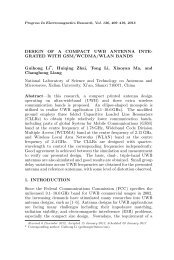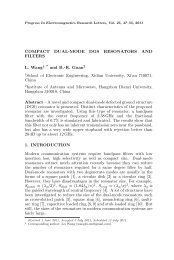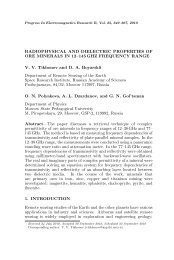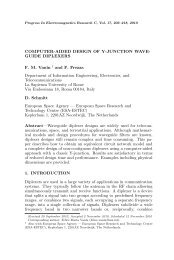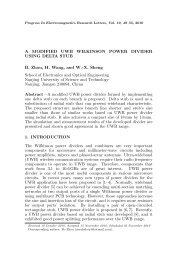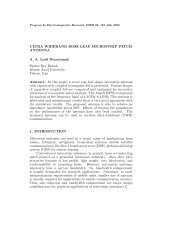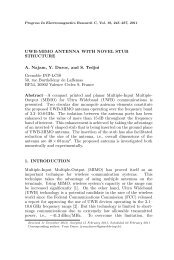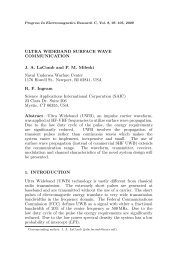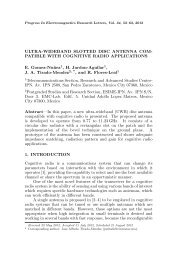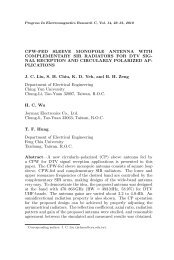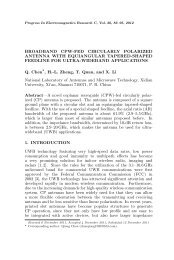PDF File (979 KB) - PIER
PDF File (979 KB) - PIER
PDF File (979 KB) - PIER
Create successful ePaper yourself
Turn your PDF publications into a flip-book with our unique Google optimized e-Paper software.
132 Angermann and Yatsyk<br />
the generation of the third harmonic. The reduction of Q κ1 starts<br />
in the region of canalisation of energy (see #1, where Figure 11(a)).<br />
The maximal generation (see #7 in Figure 11(a)) is achieved at the<br />
minimum of Q κ1 (see #1 in Figure 11(c) or #13 in Figure 11(d)). Note<br />
that in our case study we observe that Q κ1 /Q κ3 ≈ 1 3 Im(κ 3)/Im(κ 1 ),<br />
see #13 and #2 in Figure 11(d).<br />
Figure 11(b) illustrates the dispersion characteristics of the linear<br />
(α = 0) and the linearised nonlinear (α = +0.01) layer ε nκ =<br />
ε (L) + ε (NL<br />
nκ , n = 1, 2, 3. The nonlinear components of the permittivity<br />
at the scattering (excitation) frequencies κ scat := κ inc = κ and the<br />
generation frequencies κ gen := 3κ depend on the amplitude a inc<br />
κ and<br />
the angle of incidence ϕ κ of the incident field. This is reflected in the<br />
dynamics of the behaviour of the complex-valued eigen-frequencies of<br />
the linear and the linearised nonlinear layer.<br />
We start the analysis of the results of our calculations with<br />
the comparison of the dispersion relations given by the branches<br />
of the eigen-frequencies (curves #3.1, #3.2 and #5.1, #5.2) near<br />
the scattering frequency (curve #1, corresponding to the excitation<br />
frequency) and (curves #4.1, #4.2, #6.1, #6.2) near the oscillation<br />
frequency (line #2) in the situations presented in Figure 11(b). The<br />
graph #5.1 lies below the graph #3.1 and the graph #6.1 below the<br />
graph #4.1. That is, canalising properties (properties of transparency)<br />
of the nonlinear layer occur if α > 0. This case is characterised by<br />
the increase of the angle of transparency of the nonlinear structure<br />
at the excitation frequency with an increasing amplitude of the<br />
incident field. The analysis of the eigen-modes of Figure 11(b)<br />
allows us to explain the mechanisms of the canalisation phenomena<br />
(transparency) (see Figure 11(a) (graph #1)) and wave generation (see<br />
Figure 11(a) (graphs #5, #6)).<br />
Comparing the results shown in Figure 11(a) and Figure 11(b)<br />
we note the following. The intersection of the curves #1 and #5.1<br />
in Figure 11(b) defines certain parameters, in the neighborhood of<br />
which the canalisation effect (transparency) of the nonlinear structure<br />
can be observed in Figure 11(a). For example, in Figure 11(b) the<br />
curves #1 and #5.1 intersect at a inc<br />
κ = 9.5, also here the curve #5.2<br />
achieves a local maximum. Near this value, we see the phenomenon<br />
of canalisation (transparency) of the layer in Figure 11(a). At the<br />
point of intersection of the curves #2 and #6.1, the graph #5.2<br />
starts to decrease monotonically in some interval. The intersection<br />
of the curves #2 and #6.1 defines the parameter a inc<br />
κ = 12.6, which<br />
falls into the range [9.5, 13.6] of values of the amplitudes at which<br />
the curve #5.2 is monotonically decreasing. This leads to a shift in<br />
the imaginary part of the eigen-frequency of the scattering structure




